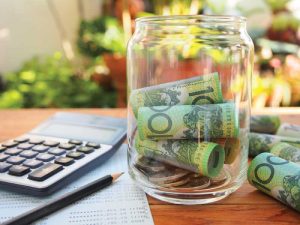
Let’s continue to look at ways you can purchase property with little or no money down. Most people know that banks and financiers take mortgages over properties when someone borrows money to buy the property. But it’s not only banks and other financial institutions that can be mortgage holders over property you buy.
There is a private mortgage market in Australia. Often the financing is completed through a mortgage broker who organises loan money directly to an end purchaser. The transaction benefits both parties, the lender who gets a much higher interest rate than they would if they’d deposited their money into a bank, and the borrower who gets finance that they may not have been able to obtain through a conventional financial institution.
Is it possible to have borrow more money than From the banks?

You may also be able to take out a second mortgage if you can demonstrate how you’ll be adding value to the property with renovations. A lender may feel more comfortable providing a second mortgage. Private mortgages arranged through finance brokers or other investors are not the only way to obtain direct finance. Many times the seller may be in a position to provide finance to the person buying their property. However, this only works with sellers who have a reasonable amount of equity in the property.
Finding the RIGHT property

Another way to find out more about the seller’s financial circumstances is to inspect the title. Under the Torrens title system, we have in Australia, mortgages and other financial encumbrances on a property are nearly always registered on the title for the protection of the mortgagee. This means it’s public knowledge if the property is encumbered by mortgages or other debts that need to be cleared before a clear title can be given.
To obtain a copy of the title, call the title office in your state and ask how to obtain a copy. On the title will be any mortgages that have been placed over the property will usually be recorded. The date they were placed, the name of the mortgagee, and the date, if any, that the mortgage was paid out. If the title you are looking at shows you the owner has paid out all their mortgages, then the seller owns the property outright and is in a flexible selling position. If the seller has purchased the property 15 years ago and has kept the same mortgage, then you can assume they have paid a reasonable percentage of the mortgage off. Out of the interim, the property price has increased, meaning the seller probably has a large amount of equity relative to the debt in the property.
Suppose the seller has been changing and adding mortgages throughout ownership, including recently. In that case, it probably means the seller is highly geared and not likely to have any significant equity in the property. This puts the seller in a much less flexible position to approach for financing.
Alternative way of acquiring property

This might be something the seller is interested in pursuing. Even if the seller has a first mortgage on the property, you could determine the amount. Obtain the first mortgage finance from somewhere else and ask the seller to take a second mortgage for the balance owed. Again, they may be willing if you can deliver a better return than they would otherwise achieve through the money being put in a bank.
The sellers may be interested in offering a mortgage on a property not only because of high interest rates but also because they’re motivated to do so. If the seller has had enough of the property maintenance or the tenants and wants to be rid of the property, they may be willing to become a lender to facilitate the deal.
Some sellers are going to be wary of lending all the purchase price or even taking a second mortgage over the property. They may not want to be connected to the property anymore, or they don’t want to be tied to a mortgage for 20 years or so. Or they may be concerned that you won’t repay the loan, meaning they’d have to take back the property from you.
There are a variety of strategies you can use to make the deal more comfortable for the seller. Firstly, offer a lower price and higher interest rate. A higher interest rate might make the loan more acceptable to the seller.
Reducing the Capital Gains for Sellers

With capital gains tax, CGT rates are much lower than they used to be. The Australian Tax Office gets much less of the pie when the property is sold. Of course, any property purchased before September 1985 is generally free of capital gains. A seller may have a capital gains liability on the property, and this may prevent them from financing all of the property.
If you lower the offer price but raise the interest rate, the seller may have less or no capital gains to pay but still have an attractive offer to consider. Over the term of the loan, the seller may effectively get the same amount of money but have to pay a lower CGT upfront. The tax laws state for CGT purposes that the property is sold at market value.
However, market value is really a range of prices. Every property is unique, and because of this, it isn’t easy to put an exact price on most properties. Therefore, if the market value for a property was AUD$300,000 to AUD $330,000, you could aim to offer a price closer to AUD $300,000 with a higher rate of interest payment.
Alternatively, you could offer a higher price with a lower interest rate. This is similar to the first strategy. If the seller has purchased a property before capital gains, then it again will generally be tax-free. If the seller was just going to put the money in the bank, you could offer a high price that would be tax-free within the range of market value but a lower overall interest rate. They might prefer the higher price they would receive.
Short Term Mortgages

You may ask the seller for a short-term mortgage of 24 months. That way, the seller can feel more comfortable. They will get their money in a shorter period of time. During that time, you may renovate the property and create enough equity that will allow you to refinance the property through conventional finance methods or sell it and pay out the mortgages and keep the profits.
Let’s now look at the option of a mortgage over other assets as a way to purchase property with little or no money down. This is a fairly simple strategy if you have equity in another investment but don’t have any cash or don’t want to use cash to purchase a property. The other asset may be another property. Whether the mortgage is from a financial institution or the property seller, it doesn’t really matter. A mortgage or second mortgage can be taken over another property as security for a loan. You can also mortgage shares if you have them.
Find out your borrow capacity
How much an I borrow?

A financial institution will typically only provide a relatively low percentage of the value of the shares or security due to the more volatile nature of the share market. And the lack of liquidity that may exist in some shares. If you’re looking to obtain vendor finance, then the percentage of the value they accept is a matter of negotiation between you and the seller.
Mortgages over other assets are a great way to release funds without having to sell the asset and enable you to purchase property with little or no money down.
Now, let’s look at joint ventures. These are fantastic ways for you to make your start in the property investment business.
Other ways to acquire property
For example, you may be able to find people who are looking to invest in property, but don’t have the time available to find a suitable property. You may be able to come to an agreement with them where you find a suitable property, and they put up the money.
You receive a percentage of ownership of the property in exchange for having found the property. You may be able to find properties that can be bought for significantly below market value that you may be able to take percentage equity in if you can find a buyer for the property. Many people have unused equity in their property.
If that were the case, then they’d probably have to come up with any cash to purchase the property. If the property were purchased for AUD$50,000 below market value, then many would be happy to share some of that windfall with you through a joint venture agreement. Before entering into a joint venture arrangement, ensure you have an experienced solicitor draw up the appropriate documentation. If it is a property development site, a developer may pay you a spotter’s fee or referral fee if you find the right property. The options are wide open for you to imagine.
Alternative way to purchase an investment property

Suppose you can buy a property significantly below market valuation. In that case, you may be able to convince a lender to lend you a percentage of the valuation rather than a percentage of the lower cost and valuation. If you purchase at more than 20% less than the market value, you may be able to buy the property with little or no money down.
It would be best if you talked to your mortgage broker or banker about any policies when you are looking to borrow, as new lenders are coming into the market all the time. And even if you pay a higher interest rate, it may be worth it if you can fully finance the property with no money down.
Should I renovate?

During that 45 days, you would pay the seller a market rent or interest, and during that time, you would renovate the property. Builders and other tradespeople are paid from the settlement proceeds. If you’re going to add value through your renovation works, you should find a lender who will agree to loan you at settlement based on the completed value after your renovations.
You may add 15% or more to the value, which means you may be able to obtain finance where you’re required to put down little or no money on settlement. There are many options for you to get involved in property investment.
Financing options have changed dramatically in Australia, so you no longer only have the option of going to see your bank manager and begging for a loan. With this information, you should now be ready to start your property investment career.













